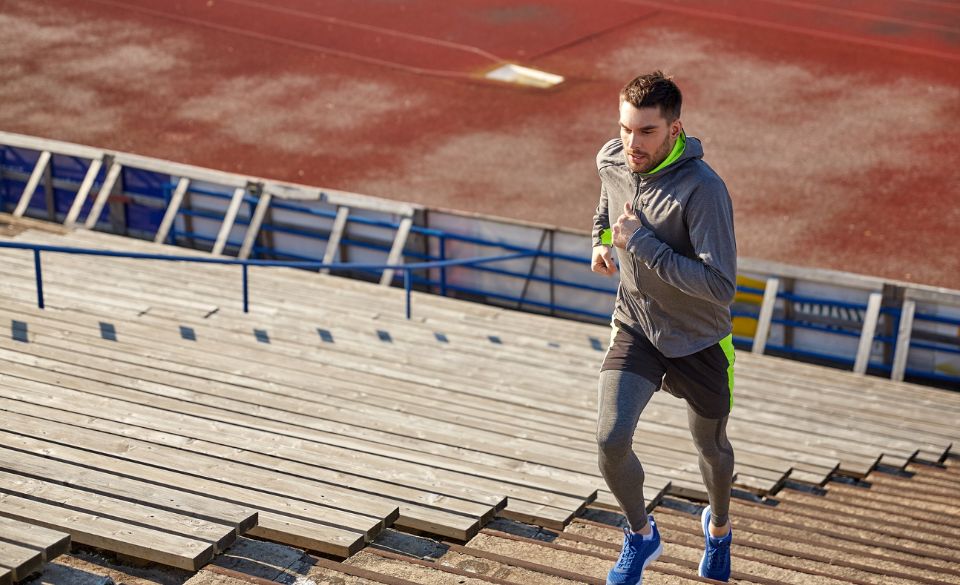
Stadium Workouts for Runners
Page Contents
When it comes to spicing up your running routine, have you considered the power of stadium workouts? These iconic structures aren’t just for cheering on your favorite sports teams – they can also become your personal fitness arena. Stadium workouts offer a unique blend of cardiovascular exercise, strength training, and stair climbing that can take your fitness to new heights. In this post, we’re stepping into the world of stadium workouts, exploring their benefits, outlining a killer routine, and uncovering seven dynamic workouts to supercharge your training.
Stadium Workout Benefits
Before we dive into the nitty-gritty of stadium workouts, let’s talk about why they’re worth your time. Stadiums provide a versatile and challenging environment that can benefit runners of all levels. The varied terrain, staircases, and open spaces make stadiums perfect for a well-rounded workout. Not only do they improve cardiovascular endurance and lower body strength, but they also engage your core and improve agility. Plus, the change of scenery from your regular running route can provide a refreshing boost to your fitness routine.
The Stadium Workout Routine
A stadium workout typically consists of a combination of running, stair climbing, and bodyweight exercises. It’s a high-intensity workout that challenges your cardiovascular system while targeting different muscle groups. Here’s a basic stadium workout routine to get you started:
1. Warm-Up: Start with a light jog around the stadium to get your muscles warmed up and your heart rate elevated.
2. Stair Climbs: Begin by climbing the stadium stairs at a moderate pace. Focus on using your entire foot and engaging your core. Climb to the top and then descend slowly, using each step to control your movement.
3. Sprints: After stair climbs, head to the open seating area for sprints. Sprint up and down rows of seats, pushing your speed to the max. These sprints will elevate your heart rate and work on your explosive power.
4. Bodyweight Exercises: In the seating area, incorporate bodyweight exercises like push-ups, squats, lunges, and tricep dips. Use the rows of seats for step-ups or incline push-ups.
5. Cool Down: Finish with a gentle jog or walk to bring your heart rate back to normal. Don’t forget to stretch your muscles, focusing on your calves, quads, hamstrings, and hip flexors.
7 Stadium Workouts Runners Can Do
1. Stair Intervals: Alternate between running up the stairs and jogging down. Aim for a certain number of repetitions or a specific time interval.
2. Pyramid Sprints: Sprint up one row of seats, jog down, then sprint up two rows, jog down, and so on. Keep increasing the number of rows you sprint up and decreasing the rest time.
3. Leg Blaster: Combine stair climbs with bodyweight squats. Climb a set of stairs, then perform 10 squats at the top. Repeat for a designated number of rounds.
4. Lateral Shuffle: Shuffle sideways up the stairs, alternating between left and right. This exercise targets your inner and outer thighs.
5. Burpee Challenge: Perform burpees at the bottom of the stairs, then sprint to the top. At the top, do another set of burpees, and jog back down. Continue this pattern.
6. Stadium Circuit: Create a circuit that includes stair climbs, push-ups, squats, and planks. Perform each exercise at a different seating section before moving to the next.
7. Hill Repeats: Use the stairs as a substitute for hill repeats. Sprint up the stairs, focusing on your form and speed, then jog back down for recovery.
Stadium Workouts: Safety and Tips for Success
As you immerse yourself in the world of stadium workouts, it’s crucial to prioritize safety and adopt strategies for a successful and injury-free experience. Here are some tips to keep in mind:
Warm-Up Thoroughly
Stadium workouts can be intense, so a proper warm-up is essential. Begin with dynamic stretches to prepare your muscles for the demands ahead. Light jogging, leg swings, and arm circles can help increase blood flow and flexibility.
Start Slow and Progress Gradually
If you’re new to stadium workouts, start with a lower intensity and fewer repetitions. Gradually increase the intensity, the number of stairs climbed, and the complexity of exercises over time. This gradual progression minimizes the risk of overuse injuries.
Maintain Proper Form
Proper form is crucial to prevent injuries and ensure effective results. Whether you’re climbing stairs or performing bodyweight exercises, focus on maintaining good posture and alignment. Engage your core muscles to stabilize your body during movements.
Stay Hydrated
Stadium workouts can be sweaty affairs, so hydration is key. Bring a water bottle and take short breaks to hydrate throughout your workout. Dehydration can impact your performance and recovery, so don’t underestimate the importance of staying hydrated.
Listen to Your Body
Pay attention to how your body feels during the workout. If you experience pain, dizziness, or excessive fatigue, it’s essential to stop and rest. Pushing through discomfort can lead to injuries, so always prioritize your safety.
Proper Footwear
Choose appropriate footwear for stadium workouts. Running shoes with good cushioning and support can help absorb the impact of stair climbing and sprints, reducing the strain on your joints.
Cool Down and Stretch
After your workout, don’t skip the cool-down. Gentle jogging and static stretches can help prevent muscle soreness and improve flexibility. Focus on stretching the muscles you worked during the workout, including your calves, quads, hamstrings, and hip flexors.
Rest and Recovery
Just like any other workout, stadium workouts require adequate rest and recovery. Make sure to schedule rest days between intense sessions to allow your muscles to recover and rebuild.
Final Thoughts: The Stadium Workout
Stadium workouts aren’t just about running laps – they’re about embracing the challenge of stairs, the power of sprints, and the creativity of bodyweight exercises. Whether you’re training for a race, aiming to improve your overall fitness, or simply seeking a change of pace, stadium workouts offer a dynamic and effective option. Remember to start at your own pace, stay hydrated, and listen to your body. So, lace up your running shoes, find a local stadium, and elevate your training routine to new heights with these invigorating and rewarding workouts.




